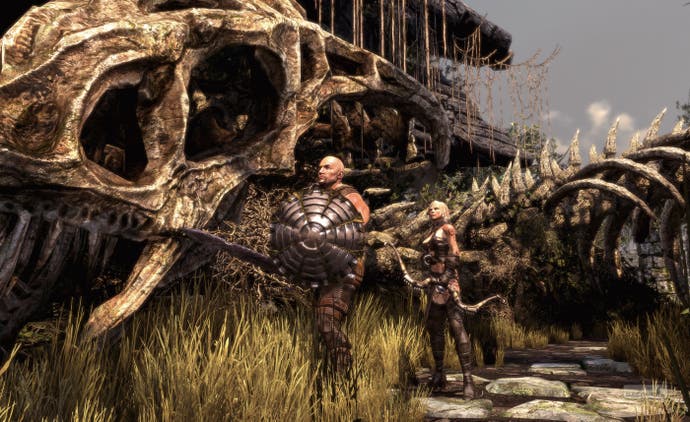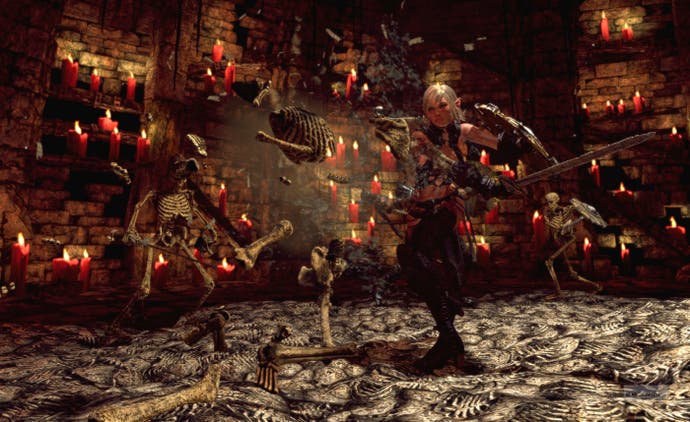Hunted: The Demon's Forge
inXile comes home.
At a checkpoint, Kaufman and Findley switch characters - this is also where you can buy new abilities for them - and it's time to leave the narrative path behind. Using the legendary Deathstone to speak to corpses reveals story details, hints and optional quests, and one dead soldier spinning a riddle about the final resting place of a king and his "axe of magic". (Part of inXile's revival of the dungeon crawl is a cheery and quite lovable embrace of fantasy cliché.)
They wander off to find the tomb, with vocal cues, triggered by the fact they listened to the Deathstone, again used as hints as they get warmer. Although the riddle itself is slightly obtuse, it's nice to see a modern action game ask its players to solve a linguistic challenge, and the reward, a hefty cleaver for Caddoc to use, is well worth the head-scratching.
They smash through some more skeletons as they move on. Caddoc shows off his brutal shield dash and Elara lights her arrows in a flaming brazier - these are among the special skills each can learn in their primary combat role. They can carry multiple primary weapons, but even their secondaries - Caddoc's bow and Elara's blade - can be upgraded.

Barely are the two back on the narrative treadmill than they fall into a pit and discover a candle-lit chamber. Only if you examine a vial here will you discover that a statue can be pushed aside, revealing an entire mini-dungeon less attentive players will sail past.
It's dank and very dark, Elara using her fire-arrows to light the way. Combat is brief and rare, with careful exploration revealing a multi-stage puzzle involving water levels, statues, levers, bridges and another riddle; it's almost Zelda-esque. There's more loot at the end of it, but a monster smashes through the wall at ends the demo before it can be claimed.
"We want everyone to stop and look around and think a little bit," says Findley. "We've been dumbing games down for 20 years, we're trying to smarten them up." On this evidence, Hunted is hardly a towering intellectual challenge, but we know what he means. Whether in the meandering, riddling side-quests or the trunk-road set-piece that starts the demo, this is a game where there is always more than meets the eye, rather than, as is so often the case, less.

It's fairly simple stuff, but it's also impressive on several levels: the smoothness with which players are led off the garden path, the amount of stuff there is to find when they do, the level of care and polish invested in content many players will never see, and above all the pacing - the way quiet, deliberate exploration, intense battles, more isolated combat and puzzle-solving are all folded into each other. inXile now has until the first quarter of next year to polish it further, too.
But the most striking thing about Hunted remains that no-one has really done it before. It's an obvious concept played straight, and you feel like you must have played it before, like it's just the latest entry in a well-worn genre or long-lived series. But you haven't, and it isn't. Then again, perhaps that long-lost-friend familiarity is exactly what Fargo wanted to kindle by bringing the dungeon crawl back - and with this demo, inXile has made that plain as day.
Hunted: The Demon's Forge will be released for PC, Xbox 360 and PS3 in the first quarter (January to March) of 2011.

